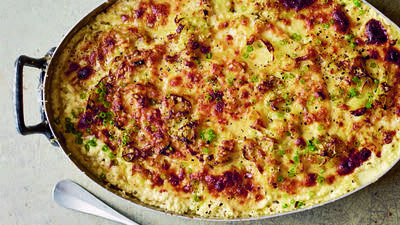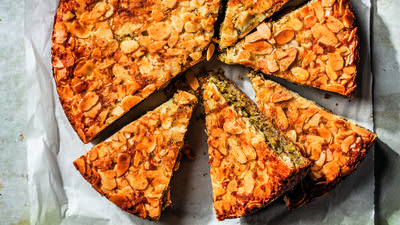
"I am just infinitely inspired by Basque cooking, Basque ingredients and the Basque landscape," says chef Alex Raij, who wrote The Basque Book with her husband, chef Eder Montero.
She also shared her recipes for Garlic Soup with Torn Salt Cod and Garden Snails in Bizkaína Sauce.
[More: Keeping the Basque tradition of cheesemaking alive]
Amy Thielen: When I think about Basque food, I think of these Basque “materia prima,” the prime materials. I’m thinking about cod, red pepper, onions, garlic and jamón serrano, that famous oily, prosciutto-like ham. What are the materials that make up Basque food? What does it mean to you?
 Alex Raij
Photo: Penny De Los Santos
Alex Raij
Photo: Penny De Los Santos
Alex Raij: They’re fairly simple. What it means to me is more that the ingredients are a direct reflection of the landscape. The foods are highly recognizable. Then when you turn them into a dish, they still reflect the landscape.
When I think about what are the hallmarks of Basque cuisine or what is it composed of, it is vegetables, lots of different kinds of lettuces; green on green is fairly common. It’s the colors of the ikurriña, the Basque flag, which are red, green and white. You end up with cod.
AT: Cod is the white part?
AR: Exactly. Salt cod and salt in general, and then any sort of white flesh fish. You think about peppers, both dried and fresh, and onions. Their onions often will have these green tops -- like a big onion bulb with the green tops. They are what are called cebolla, more like a spring onion, but also more like Vidalia. Lots of leek, cabbage and beans. Foods that are grown in the moment and then made to last. So drying out beans, drying out peppers, canning tuna, preserved foods.
AT: Tell me more about how Basque cuisine deals with the red pepper hull. Red peppers and those nice oily, rusty, red sauces are a hallmark of it. How do Basque cooks preserve their peppers?
AR: There are a number of different kinds of pepper, and each pepper has its own application. That’s one thing that is very typical of Basque cuisine is that it’s very specific. You don’t treat all peppers in the same way.
They have these beautiful, sweet peppers that have a really pliable flesh that roasts beautifully. They are called piquillo peppers. They’re great for stuffing, cutting in thin ribbons and mixing into food, or pureeing and making into vinaigrettes. Those are rarely eaten fresh. It’s a thing that you actually would buy jarred or canned, or even your grandmother would can and jar a bunch. Then you would pull them out as needed.
There are peppers that are ideal for drying. Those are the choricero peppers. They are called choricero peppers because they were used to make chorizo. They braid them up -- how people make garlic braids, hang up onion or anything that they want to be a storage vegetable. But in this case, they’re turned into these long skeins of peppers. They hang them outside their houses from their windows; that’s where they dry them out so that they have proper ventilation. This is a very typical part of the landscape that you see -- these homes with these peppers hanging off of them. They are very postcard pretty, but they do have a purpose. They have a purpose in every house because that’s the thing in the Basque Country.
Everybody cooks similarly. The personal side of it is these very subtle details or tweaks that would belong to your mother, your grandmother, your aunt’s way of doing things. But fundamentally, people eat the same from home to home, restaurant to restaurant and from home to restaurant even.
 Raij's recipe: Garden Snails in Bizkaína Sauce
Photo: Penny De Los Santos
Raij's recipe: Garden Snails in Bizkaína Sauce
Photo: Penny De Los Santos
AT: I love that simplicity. It’s so different from American food, where the sky is the limit. Basque food seems very codified to me. It’s loyal to the season, but also to all these traditions. How does your creativity operate in that structure? Do you find that you like to work inside those limits or do you just not follow them at all?
AR: I have too high of a regard for Basque food to take too many liberties. I want it to be recognized as Basque food, especially because I’m not cooking in the Basque Country. We’ve had the privilege of always cooking on our own terms. But, having said that, we define our style very, very narrowly, much more narrowly than might be satisfying to another kind of cook.
I am just infinitely inspired by Basque cooking, Basque ingredients and the Basque landscape. Even though it’s narrow, I don’t find it limiting at all. In fact, I find it more freeing. There’s a logic that is not arbitrary at all. That brings a lot of elegance and grace to our cooking.
AT: That reminds me of a sauce I really want to hear more about: Salsa Bizkaína. That’s one of those red pepper-based sauces.
 The Basque Book
The Basque Book
AR: I’m actually glad you asked about that sauce because the Basque Country is composed of all these little provinces and towns. Bizkaia is where my husband is from, so he feels super strongly about that particular sauce.
AT: It looks so good. I love how you describe it as “doped up” with bacon and chorizo.
AR: I’m always looking for equivalents for people. For me, that sauce is like the Basque version of all'amatriciana sauce. If that’s a pasta sauce that you like, you would love this dish. It has good textures; it has this deep, rich, sunburnt flavor to it. It’s also just incredibly unique. I have to draw comparisons to other things, and yet I’ve never had anything like that sauce anywhere else. It’s just very mellow and balanced.
We make a snail stew. We buy Burgundy and escargot. We chop up pieces of chorizo, ham, bacon and bay leaf, then we braise them in that sauce.
AT: How does cooking Basque food filter down to the way that you live your daily life?
AR: The thing about Basque cooking is that everybody in the Basque Country and everybody in my house, all my life, cooks. It’s not something that you choose to do, you do it because it’s part of who you are. People might do it with more or less pleasure, but they never do it halfway. There’s not a loveless meal in the Basque Country.
Before you go...
Each week, The Splendid Table brings you stories that expand your world view, inspire you to try something new, and show how food connects us all. We rely on your generous support. For as little as $5 a month, you can have a lasting impact on The Splendid Table. And, when you donate, you’ll join a community of like-minded individuals who love good food, good conversation, and kitchen companionship. Show your love for The Splendid Table with a gift today.
Thank you for your support.
Donate today for as little as $5.00 a month. Your gift only takes a few minutes and has a lasting impact on The Splendid Table and you'll be welcomed into The Splendid Table Co-op.




